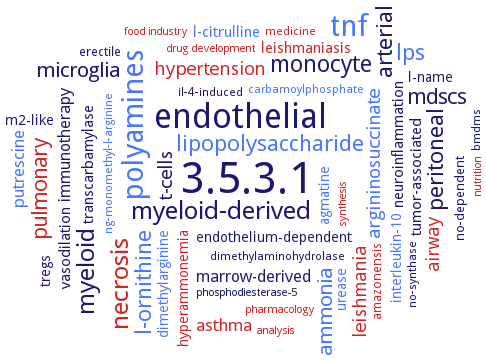3.5.3.1: arginase
This is an abbreviated version!
For detailed information about arginase, go to the full flat file.

Word Map on EC 3.5.3.1 
-
3.5.3.1
-
endothelial
-
tnf
-
polyamines
-
myeloid-derived
-
necrosis
-
myeloid
-
monocyte
-
arterial
-
lps
-
lipopolysaccharide
-
peritoneal
-
l-ornithine
-
mdscs
-
pulmonary
-
microglia
-
ammonia
-
t-cells
-
argininosuccinate
-
airway
-
leishmania
-
hypertension
-
asthma
-
putrescine
-
immunotherapy
-
marrow-derived
-
tumor-associated
-
leishmaniasis
-
transcarbamylase
-
vasodilation
-
neuroinflammation
-
l-citrulline
-
dimethylarginine
-
interleukin-10
-
tregs
-
l-name
-
endothelium-dependent
-
urease
-
agmatine
-
m2-like
-
hyperammonemia
-
no-dependent
-
amazonensis
-
erectile
-
no-synthase
-
medicine
-
dimethylaminohydrolase
-
ng-monomethyl-l-arginine
-
bmdms
-
carbamoylphosphate
-
il-4-induced
-
analysis
-
synthesis
-
pharmacology
-
food industry
-
drug development
-
nutrition
-
phosphodiesterase-5
- 3.5.3.1
- endothelial
- tnf
- polyamines
-
myeloid-derived
- necrosis
- myeloid
- monocyte
- arterial
- lps
- lipopolysaccharide
- peritoneal
- l-ornithine
-
mdscs
- pulmonary
- microglia
- ammonia
- t-cells
- argininosuccinate
- airway
- leishmania
- hypertension
- asthma
- putrescine
-
immunotherapy
-
marrow-derived
-
tumor-associated
- leishmaniasis
-
transcarbamylase
-
vasodilation
-
neuroinflammation
- l-citrulline
- dimethylarginine
- interleukin-10
-
tregs
-
l-name
-
endothelium-dependent
- urease
- agmatine
-
m2-like
- hyperammonemia
-
no-dependent
- amazonensis
-
erectile
- no-synthase
- medicine
-
dimethylaminohydrolase
- ng-monomethyl-l-arginine
-
bmdms
- carbamoylphosphate
-
il-4-induced
- analysis
- synthesis
- pharmacology
- food industry
- drug development
- nutrition
- phosphodiesterase-5
Reaction
Synonyms
ARG, Arg I, Arg II, ARG1, ARG2, ARGAH1, ARGAH2, ArgI, arginase, arginase 1, arginase 1a, arginase 1b, arginase 2a, arginase 2b, arginase I, arginase II, arginase type I, arginase-1, arginase-2, arginase1, arginine amidinase, arginine amidohydrolase-1, arginine amidohydrolase-2, arginine transamidinase, canavanase, human arginase type I, Kidney-type arginase, L-arginase, L-arginine amidino hydrolase, L-arginine amidinohydrolase, L-arginine amidohydrolase, L-arginine ureahydrolase, Liver-type arginase, mitochondrial arginase, More, Non-hepatic arginase, PMN arginase, recombinant human arginase I, rhArg-PEG, rhArg1, RocF, serum arginase, SmARG, tissue arginase, type II arginase


 results (
results ( results (
results ( top
top





